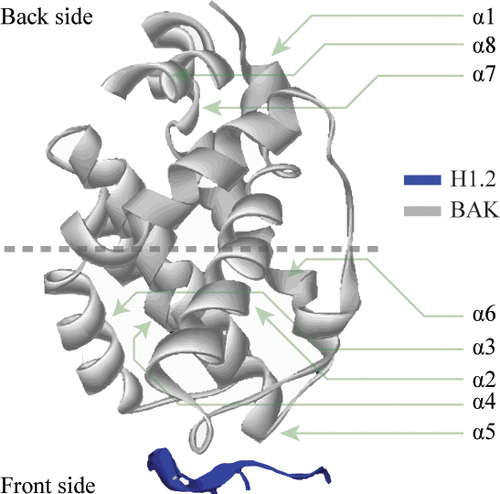当前位置:
X-MOL 学术
›
Biochemistry
›
论文详情
Our official English website, www.x-mol.net, welcomes your feedback! (Note: you will need to create a separate account there.)
Linker Histone H1.2 Directly Activates BAK through the K/RVVKP Motif on the C-Terminal Domain.
Biochemistry ( IF 2.9 ) Pub Date : 2020-08-11 , DOI: 10.1021/acs.biochem.0c00373 Rozanné Schnetler 1 , Sylvia Fanucchi 2 , Tudor Moldoveanu 3 , Gerrit Koorsen 1
Biochemistry ( IF 2.9 ) Pub Date : 2020-08-11 , DOI: 10.1021/acs.biochem.0c00373 Rozanné Schnetler 1 , Sylvia Fanucchi 2 , Tudor Moldoveanu 3 , Gerrit Koorsen 1
Affiliation

|
H1.2 is a key mediator of apoptosis following DNA double-strand breaks. The link between H1.2 and canonical apoptotic pathways is unclear. One study found that H1.2 stimulates cytochrome c (Cyt c) release; in contrast, apoptosis-inducing factor was found to be released in another study. The C-terminal domain (CTD) of H1.2 has been implicated in the latter pathway, but activation of the proapoptotic protein BCL-2 homologous antagonist/killer (BAK) is a common denominator in both pathways. This study aimed to determine whether the CTD of H1.2 is also responsible for mitochondrial Cyt c release and whether a previously identified K/RVVKP motif in the CTD mediates the response. This study investigated if H1.2 mediates apoptosis induction through direct interaction with BAK. We established that the CTD of H1.2 stimulates mitochondrial Cyt c release in vitro in a mitochondrial permeability transition-independent manner and that the substitution of a single valine with threonine in the K/RVVKP motif abolishes Cyt c release. Additionally, we showed that H1.2 directly interacts with BAK with weak affinity and that the CTD of H1.2 mediates this binding. Using two 20-amino acid peptides derived from the CTD of H1.2 and H1.1 (K/RVVKP motif inclusive), we determined the main residues involved in the direct interaction with BAK. We propose that H1.2 operates through the K/RVVKP motif by directly activating BAK through inter- and intramolecular interactions. These findings expand the view of H1.2 as a signal-transducing molecule that can activate apoptosis in a BAK-dependent manner.
中文翻译:

Linker Histone H1.2 通过 C 末端域上的 K/RVVKP 基序直接激活 BAK。
H1.2 是 DNA 双链断裂后细胞凋亡的关键介质。H1.2 与典型凋亡途径之间的联系尚不清楚。一项研究发现 H1.2 刺激细胞色素c (Cyt c ) 的释放;相反,在另一项研究中发现细胞凋亡诱导因子被释放。H1.2 的 C 末端结构域 (CTD) 与后一种途径有关,但促凋亡蛋白 BCL-2 同源拮抗剂/杀伤剂 (BAK) 的激活是这两种途径的共同点。本研究旨在确定 H1.2 的 CTD 是否也负责线粒体 Cyt c释放以及 CTD 中先前确定的 K/RVVKP 基序是否介导反应。本研究调查了 H1.2 是否通过与 BAK 的直接相互作用介导细胞凋亡诱导。我们确定 H1.2 的 CTD在体外以与线粒体通透性转换无关的方式刺激线粒体 Cyt c释放,并且在 K/RVVKP 基序中用苏氨酸取代单个缬氨酸消除了 Cyt c发布。此外,我们发现 H1.2 以弱亲和力直接与 BAK 相互作用,并且 H1.2 的 CTD 介导了这种结合。使用源自 H1.2 和 H1.1 的 CTD 的两个 20 个氨基酸肽(包括 K/RVVKP 基序),我们确定了与 BAK 直接相互作用的主要残基。我们建议 H1.2 通过 K/RVVKP 基序通过分子间和分子内相互作用直接激活 BAK 发挥作用。这些发现扩展了 H1.2 作为信号转导分子的观点,可以以 BAK 依赖性方式激活细胞凋亡。
更新日期:2020-09-15
中文翻译:

Linker Histone H1.2 通过 C 末端域上的 K/RVVKP 基序直接激活 BAK。
H1.2 是 DNA 双链断裂后细胞凋亡的关键介质。H1.2 与典型凋亡途径之间的联系尚不清楚。一项研究发现 H1.2 刺激细胞色素c (Cyt c ) 的释放;相反,在另一项研究中发现细胞凋亡诱导因子被释放。H1.2 的 C 末端结构域 (CTD) 与后一种途径有关,但促凋亡蛋白 BCL-2 同源拮抗剂/杀伤剂 (BAK) 的激活是这两种途径的共同点。本研究旨在确定 H1.2 的 CTD 是否也负责线粒体 Cyt c释放以及 CTD 中先前确定的 K/RVVKP 基序是否介导反应。本研究调查了 H1.2 是否通过与 BAK 的直接相互作用介导细胞凋亡诱导。我们确定 H1.2 的 CTD在体外以与线粒体通透性转换无关的方式刺激线粒体 Cyt c释放,并且在 K/RVVKP 基序中用苏氨酸取代单个缬氨酸消除了 Cyt c发布。此外,我们发现 H1.2 以弱亲和力直接与 BAK 相互作用,并且 H1.2 的 CTD 介导了这种结合。使用源自 H1.2 和 H1.1 的 CTD 的两个 20 个氨基酸肽(包括 K/RVVKP 基序),我们确定了与 BAK 直接相互作用的主要残基。我们建议 H1.2 通过 K/RVVKP 基序通过分子间和分子内相互作用直接激活 BAK 发挥作用。这些发现扩展了 H1.2 作为信号转导分子的观点,可以以 BAK 依赖性方式激活细胞凋亡。



























 京公网安备 11010802027423号
京公网安备 11010802027423号